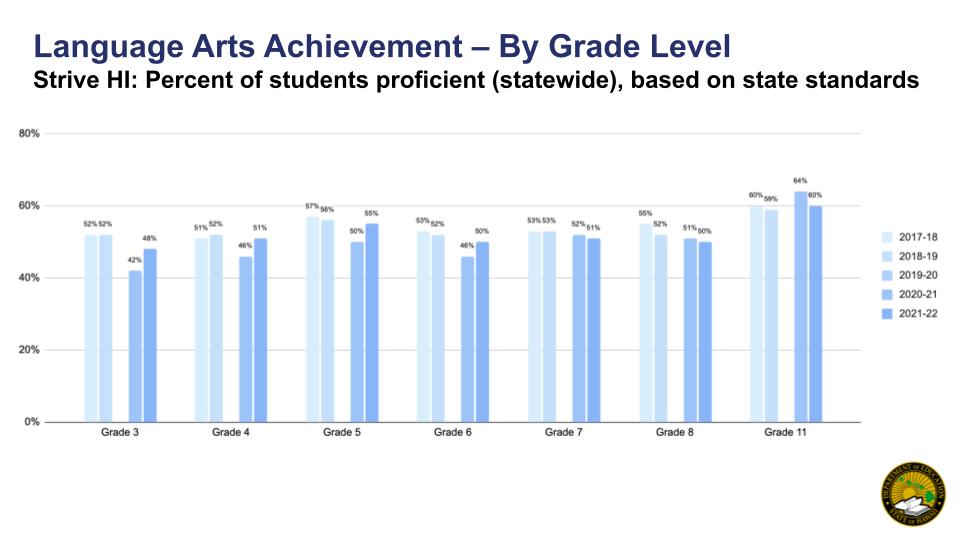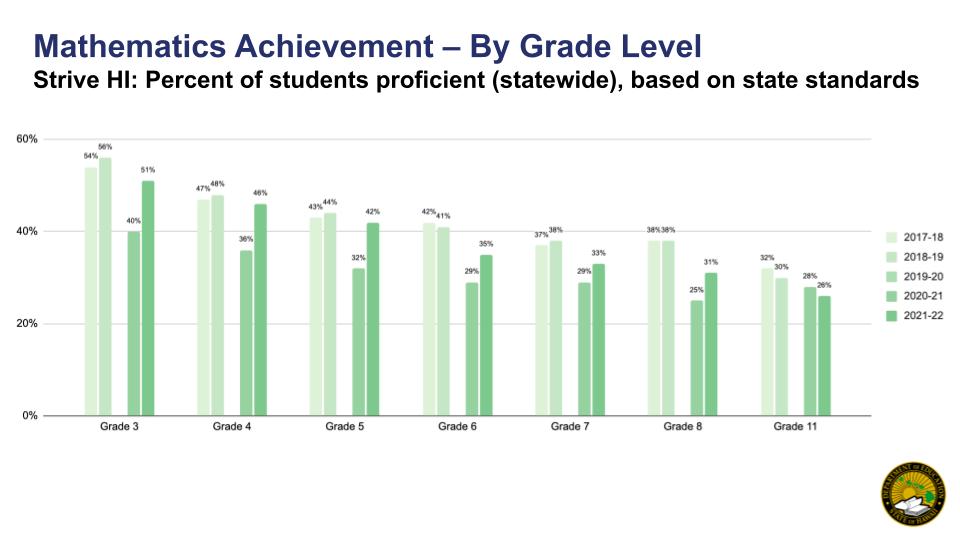2021-22 Strive HI performance data reflect positive progress in HIDOE student academic recovery and acceleration
The data — reflecting the first full school year of in-person learning following the pandemic — show gains in academic performance across core subject areas and improvements in student success indicators.
(TRANSLATION: The bottom 37% of students are chronically absent, let's see how much their absence improves test scores.)
News Release from Hawaii DoE, 12-Oct-2022
The Hawaii State Department of Education (HIDOE) today released its annual Strive HI Performance System results from the 2021-22 school year. The data — reflecting the first full school year of in-person learning following the pandemic — show gains in academic performance across core subject areas and improvements in student success indicators.
“By prioritizing a return to in-person learning last school year, schools were able to implement data-driven strategies to support and accelerate student learning. These include small-group instruction, intervention blocks, tutoring, out-of-school-time programs, academic coaching, personalized activities, and behavioral and social-emotional assessments,” Superintendent Keith Hayashi said. “Still, last school year was far from a normal year. The encouraging growth we are seeing is a testament to our educators who are counteracting the effects of the pandemic.”
American Rescue Plan Elementary and Secondary School Emergency Relief (ESSER III) Funds were provided to the Department in 2021 to support the safe reopening of schools and to mitigate student learning loss. Through the support of these federal funds, all HIDOE schools — with guidance and support from their complex area — have been able to implement and develop specific programs and interventions to support the specific needs of their students who were impacted by the pandemic.
Key year-over-year 2021-22 Strive HI results
Statewide academic proficiency in English language arts, math and science increased.
- Language arts proficiency increased by 2 percentage points to 52% in 2022.
- Math proficiency increased by 6 points to 38%.
- Science proficiency increased by 5 points to 40%.
- Ninth-grade on time promotions increased by four points to 89%. (With 37% chronic absenteeism)
- Career and Technical Education (CTE) program completion increased by three points to 64%.
- On-time graduation rate was maintained at 86%. (With 37% chronic absenteeism)
- College-going rate continued to be impacted by the pandemic at 50%.
“The Smarter Balanced Assessments (SBA), which are used to assess student academic proficiency, are a common indicator of college and career readiness, so these gains are significant because these assessments reflect very high standards. Nationally, Hawaii exceeded, matched or is within two points of other states that have reported SBA results for English language arts and math,” Deputy Superintendent Tammi Oyadomari-Chun said. “This assessment is one of many tools that schools use to track and measure academic progress and growth, including universal screeners, formative assessments and regular check-ins to plan and inform academic approaches.”
In line with national trends, chronic absenteeism rates — especially in elementary school students — saw a substantial increase to 37% from 18% the year prior, mainly as a result of COVID-19 quarantine and isolation requirements for students. Statewide bus driver shortages and the U.S. Navy emergency fuel storage leak situations were also contributing factors to the increase in absenteeism.
Despite the student absenteeism rate, the Department saw academic proficiency gains across all student subgroups, including but not limited to, English learners, students receiving special education services and economically disadvantaged students.
Kaunakakai Elementary
Reflecting statewide trends, Kaunakakai Elementary on Molokai saw double-digit growth in student academic proficiencies across all subjects. From school year 2020-21 to 2021-22, scores for English language arts increased by 12 percentage points to 43%, math increased by 22 points to 40%, and science increased by 33 points to 45%, putting the school over complex area averages and nearly on par with statewide averages. The school’s third-grade literacy levels also surpassed statewide averages this year by four percentage points at 84%.
The gains were established even through high rates of student absenteeism. Kaunakakai’s chronic absenteeism rates increased two-fold as a result of the pandemic, yet the dedication and commitment of the school’s teachers and staff in supporting student learning no matter where the students physically were, was critical to the academic success reflected in their results, according to Principal Daniel Espaniola.
“Our teachers really went above and beyond to help students and their families during this difficult time,” Espaniola said. “They voluntarily recorded lessons and posted them online, established strong platforms and open lines of communication with families, and offered additional support opportunities like after-school tutoring for those in need.”
Access to technology was also prioritized during this time to ensure that technology and connectivity were not barriers to student learning. To achieve this, the school implemented a 2:1 electronic device to student ratio — one device for home and one for school use — and also distributed wireless hotspots to families without internet connectivity at home through the use of ESSER funds.
Wheeler Middle
Wheeler Middle School on Oahu also saw significant gains in student academic proficiencies across all subjects. From school year 2020-21 to 2021-22, scores for English language arts increased by 11 points to 77%, math increased by 18 points to 57%, and science increased by 6 points to 67%, putting the school over complex area and statewide averages by double-digits. The school’s eighth-grade literacy level was 94%, surpassing statewide averages by 18 points.
Structured teacher planning time is one system that played a crucial role in Wheeler Middle’s positive results this school year, according to Principal Brenda Vierra-Chun. While students are in elective classes, core subject teachers are given the time to collaborate with one another and prepare for instruction. These sessions, led by academic coaches, allow teachers to look at student learning data, discuss the effectiveness of instructional approaches, and strategize for intervention as necessary. Student data is pulled from a variety of sources, one of the main being “daily checks for understanding” — a school-wide standard in all core classes where students are posed with a question or problem to help gauge their understanding of the day’s lesson.
Though especially helpful in addressing pandemic impacts to student learning, these systems have been in place for decades. “Everything we do at our school is very intentional and by design,” Vierra-Chun said. “Our curriculum and instruction is very much engineered. We are constantly looking at student data to see what worked well, what didn’t, and where we can improve.”
Wheeler Middle also credited the implementation of ESSER-funded, school-based summer learning hubs as a major factor in helping to accelerate student learning over the past two years. All students were encouraged to attend the school’s summer learning hub for extended learning time geared toward academic enrichment, intervention or remediation.
“While we are extremely proud of the improvements made over the last year, national research tells us that full student academic recovery can take up to three years or longer,” Superintendent Hayashi added. “Our overarching goal is to have continuous academic gains among all student subgroups beyond just the pandemic learning gaps. It’s very promising to see how the federal funds have supported our schools in getting to this point and we will work hard to secure the financial support to continue to invest in and accelerate the strategies that are making a difference for our students.”
This is the first school year since 2018-19 that data has not been impacted by pandemic-related accountability and assessment waivers. For the 2021-22 school year, the U.S. Department of Education offered states a waiver from some accountability requirements including the 95% participation rate requirement, in anticipation of lower-than-normal participation rates. For the 2019-20 school year, U.S. DOE offered states the option to waive required statewide assessments, and no statewide tests were administered.
Strive HI was launched in the 2012-13 school year as the state's locally designed school improvement and accountability system that offered flexibility from the former federal No Child Left Behind (NCLB) law. It includes multiple measures of school performance including proficiency in science, math and language arts/literacy; achievement gaps; chronic absenteeism; academic growth; and graduation rates. The system was modified in 2017 to align with the revised HIDOE/BOE Strategic Plan and reauthorization of federal education law under the Every Student Succeeds Act (ESSA).
(TRANSLATION: DoE designs HI-Strive to hide their failure. Just wait til NAEP and ACT come out for the real deal.)
Click here to view the 2021-22 State Snapshot of Strive HI indicators. For more information about the Strive HI performance system, click here.
 Click here to download a PDF of the data below.
Click here to download a PDF of the data below.
(EDITOR'S NOTE: Per the text of this news release, the Language Arts numbers should be 50% and 52% not 54% and 54% for 2020-21 and 2021-22 respectively.)




COVERAGE:
Background: